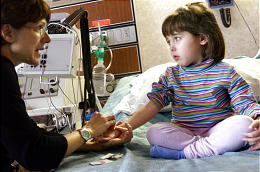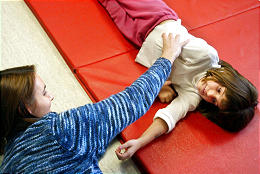| Project
cure: Study targets child disease
Saturday,
January 25, 2003
By Elaine
Jarvik
Deseret News staff writer
It's a disease currently without a cure — and also without a
celebrity. With no Christopher Reeve or Michael J. Fox to get the word
out, spinal muscular atrophy is less known than other genetic diseases,
even though it affects one in every 6,000 children and is the leading
genetic killer of children under 2.
|

Kathy
Swoboda, left, the principal investigator of Project Cure SMA,
tests 4-year-old Claire Gibbs, who has spinal muscular atrophy,
at the University of Utah.

Johanna
Kirk, Deseret News
|
But SMA has one thing
on its side: It turns out that curing the disease doesn't require
traditional gene therapy, and in fact it may be reversed by drug therapy
alone. Researchers rushing to develop that drug got a boost Friday from
"Project Cure SMA" and its first international meeting, held
at the University of Utah Medical Center.
Researchers from five countries joined U.
doctors to study 20 SMA children, to come up with ways to measure
whether those future drugs are effective.
Nikolas and Gidget Winward of Lehi spent
the day undergoing motor neuron, bone density and strength testing.
Five-year-old Nikolas wants to be the first child to try a drug once
it's developed. "I just want to be a dad and be able to walk with
my kids and play baseball," he told his mom. "You know, it's
not really fair," he told her recently, as he ticked off the other
members of his family who are mobile. "Even the dogs can
walk."
Nikolas and his 3-year-old sister Gidget
both have Type II SMA, a milder form of the disease that, unlike Type I,
is not fatal but leaves children with varying degrees of weakness and at
increased risk for complications from respiratory infections.
Like most Americans, Kim Winward had
never heard of SMA before her son was diagnosed at 18 months. Like most
children with SMA, says Winward, Nikolas is bright and very social. He
said his first word at six months, his first full sentence at 18 months,
and he crawled early. But by 15 months the crawling became more and more
labored, and he had stopped pulling himself up to standing.
|

Physical
therapist Natalie Mellen works with Lauren Gibbs, 6, who has
spinal muscular atrophy, at the U. The disease affects one in
every 6,000 children.

Johanna
Kirk, Deseret News
|
Because SMA is a
recessive disease, in most cases neither a parent nor even a close
relative has the disease, so the diagnosis isn't expected.
Winward, who is now president of the Utah
chapter of Families of SMA, is buoyed by FSMA-funded drug trials in
which mice genetically manipulated to have SMA have been restored to
full movement. Currently, however, those experimental drugs are either
too toxic or are so quickly degraded by the liver that continuous IVs
would be necessary, says Dr. Thomas Crawford, a researcher from Johns
Hopkins who is attending the Project Cure SMA meeting.
But, he says, "there's every reason
to be optimistic" about the future of SMA research.
SMA is affected by two genes, so even
when one isn't working there is a near identical copy that is. The
trick, then, is to increase the amount of "gene expression" in
that remaining gene, and this can be done through medication.
Now that the prospect of drug therapy
"is around the corner" and clinical trials are imminent, says
Crawford, researchers have to figure out how to measure whether
experimental drugs are effective. "It turns out it's not that
easy," he says.
One way is to measure the health of the
child's nerves by counting motor neurons — research that has been
pioneered by Dr. Kathryn Swoboda at the U. Because SMA affects the motor
neurons, says Crawford, "it's like genetic polio."
E-mail: jarvik@desnews.com

|
![]()
![]()
![]()